Finally, a goal achieved but it took me almost ten years.
Twelve days ago I posted a series of photos of a male Northern Mockingbird performing the distinctive courtship display of the species referred to as the “flight display”. But that series was incomplete because I lost focus on the bird during his performance so I left many photos out. For years it’s been one of my goals to photograph the display from beginning to end without any skips or soft photos and yesterday on Antelope Island I finally succeeded. Multiple times.
Part of the trouble I’ve had in the past has been that I was too close to include both the bird and the bush it had been perched on in most or all of the photos. Including both is preferrable for two reasons: it provides the desired perspective of how far the bird is above the bush at every point during the performance and (for complicated reasons) it makes it easier for me to keep the bird in the frame and in sharp focus.
Here’s how Cornell’s Birds of the World describes the flight display of the Northern Mockingbird (I included this description in my post 12 days ago). You be the judge of how accurately Cornell describes what I photographed.
“A “flight display” is given from a high singing perch. A singing male jumps upward, flaps his wings once or several times, ascends a meter or two above the perch, and then parachutes down, wings open, onto the same or a nearby perch. White wing patches are conspicuous during the display, and the bird sings continuously.”
I’m posting one of yesterday’s performances below. The first 11 photos are sequential without any skips. The photos mostly speak for themselves so I’ll keep my narration to a minimum.

I don’t know whether to call this photo the end of his previous flight display or the beginning of his next performance because this time he performed again immediately after landing following his previous display.
All the tiny black specks you see are midges that were disturbed by his landing. Thankfully, that early in the morning it was still cold enough to keep the island’s notorious biting gnats at bay. If they’d been out I’d have spent more time swatting no-see-ums than I would have taking photos.
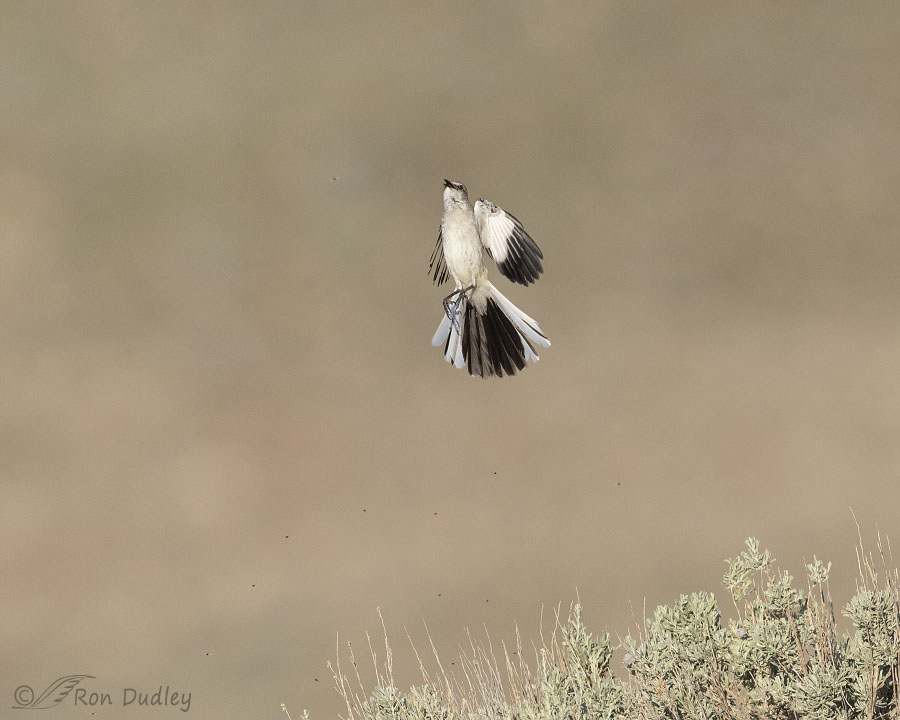
I wasn’t very quick on the trigger when he began the display so he’s already some distance above his sagebrush perch.
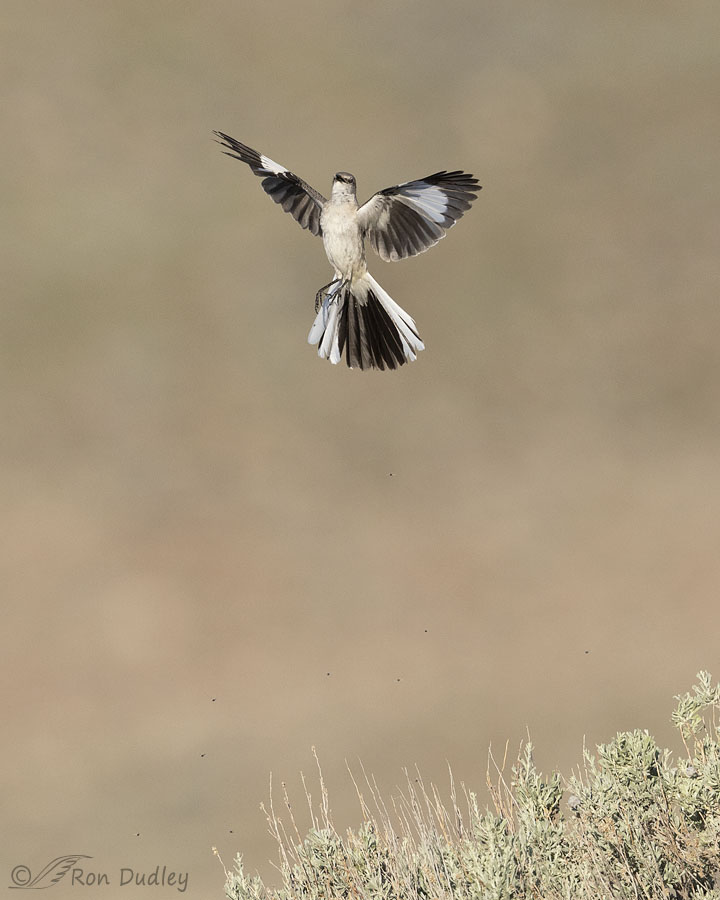
Still gaining altitude.
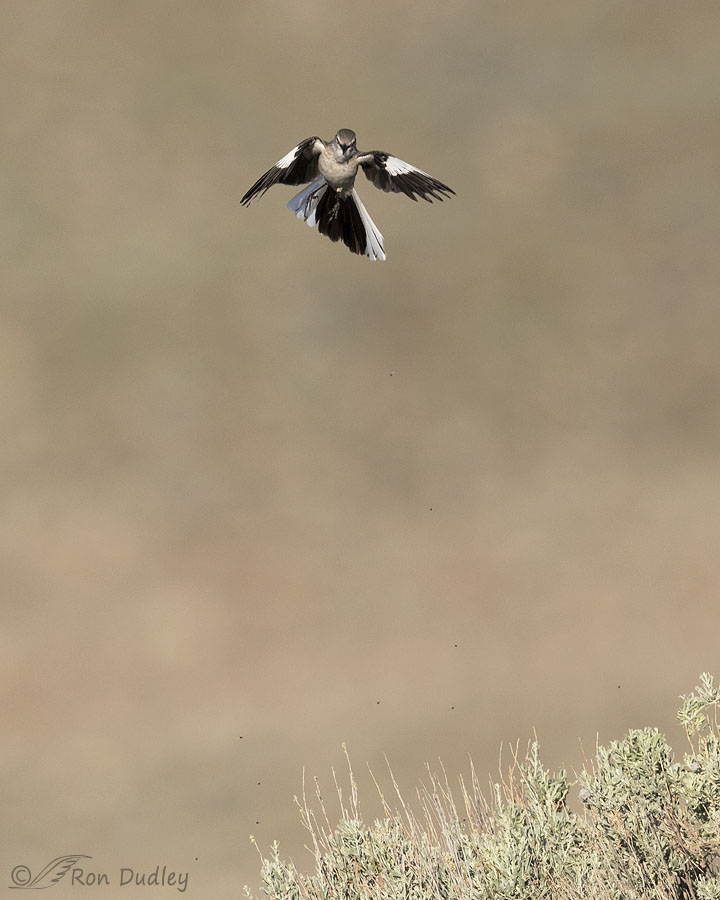
He’s nearly reached the apex of his vertical flight.
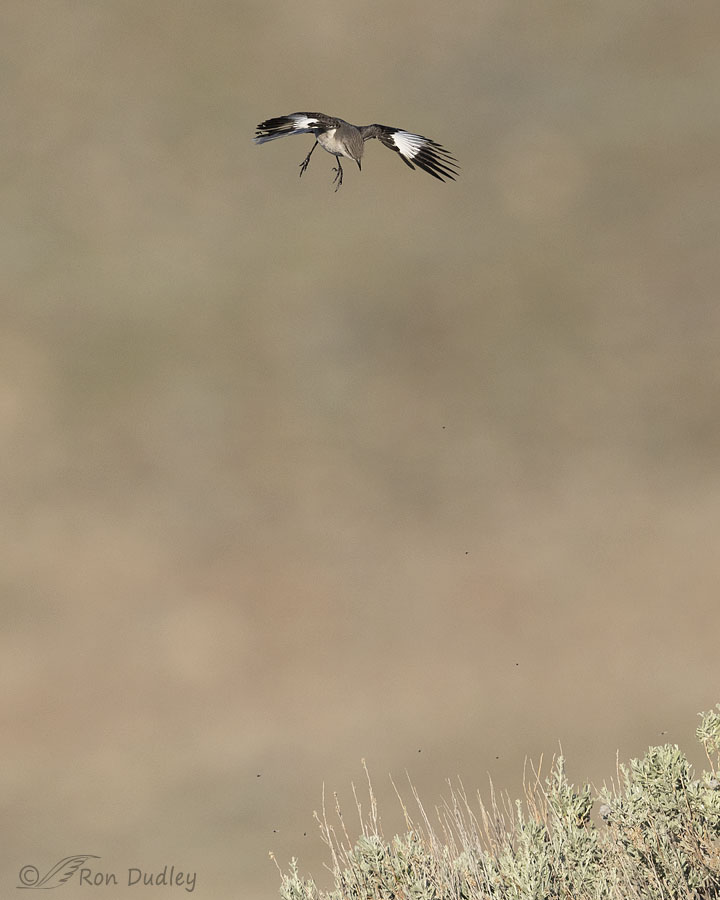
His descent was a combination of parachuting down and…
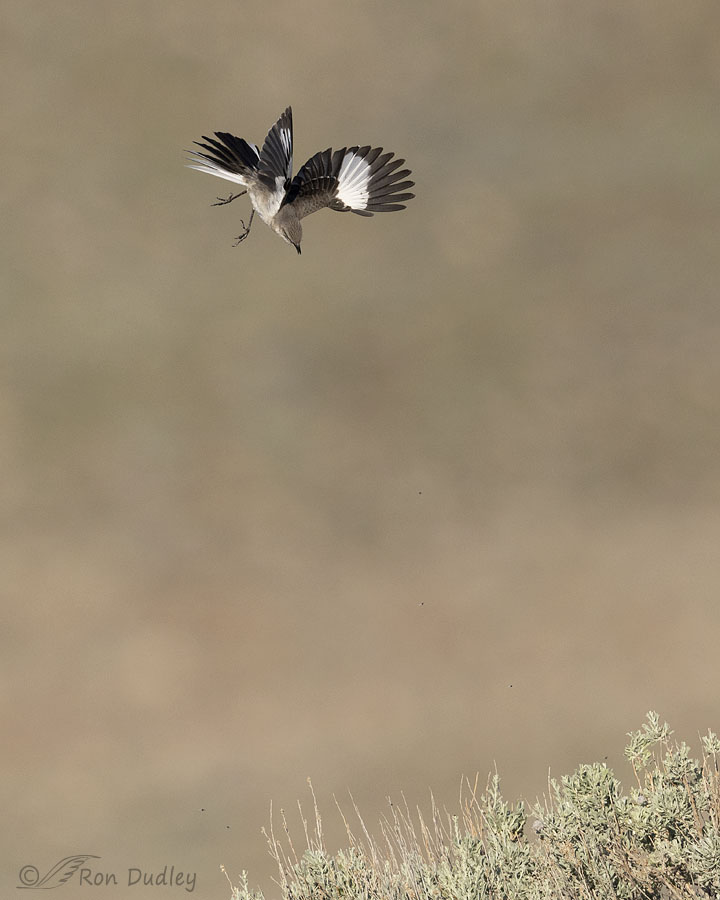
diving down.
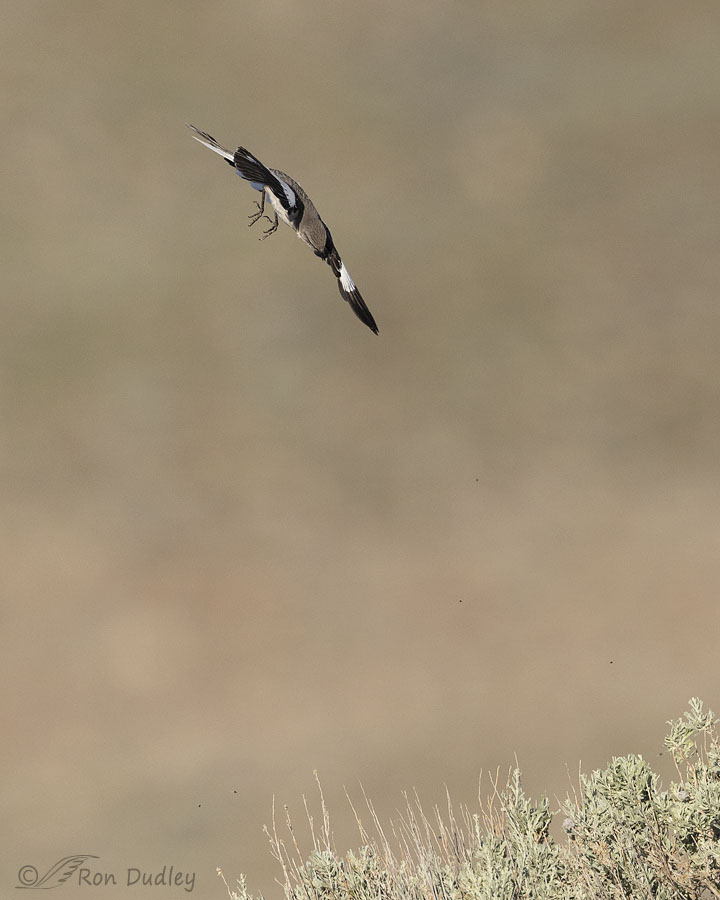
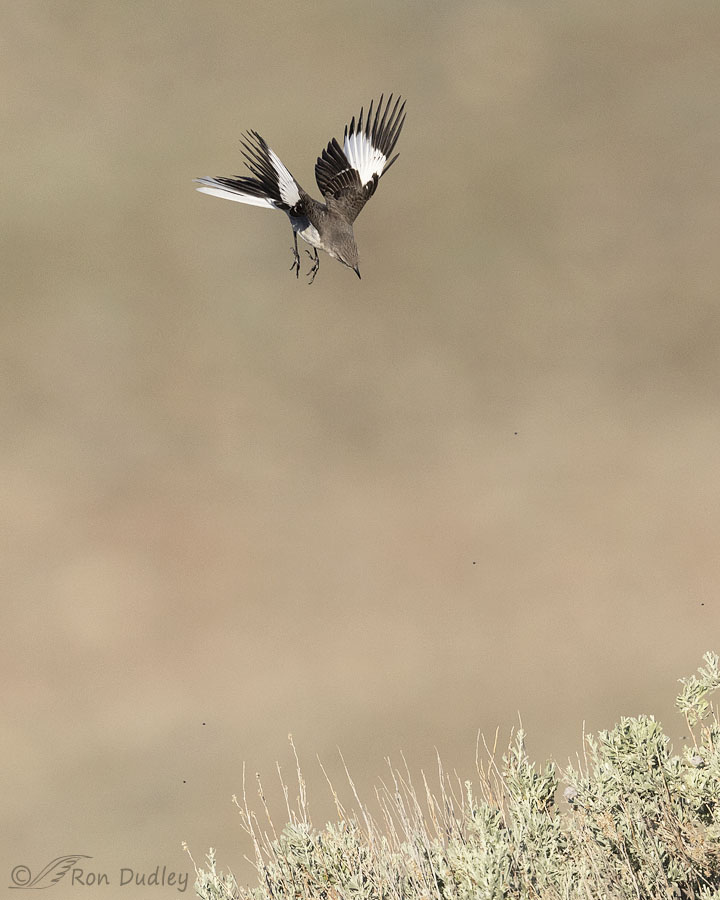
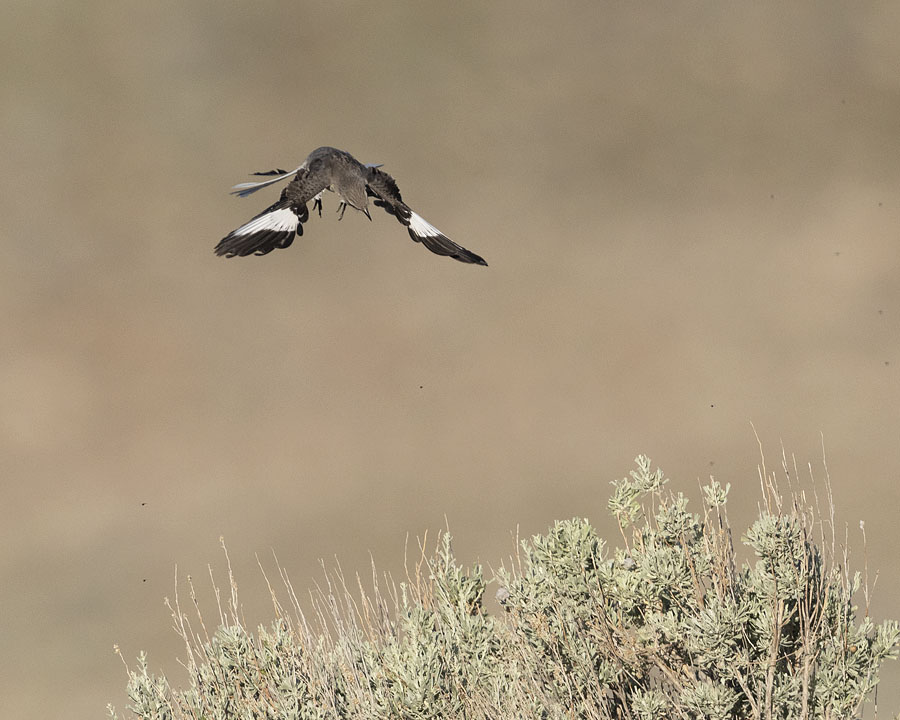
More parachuting.
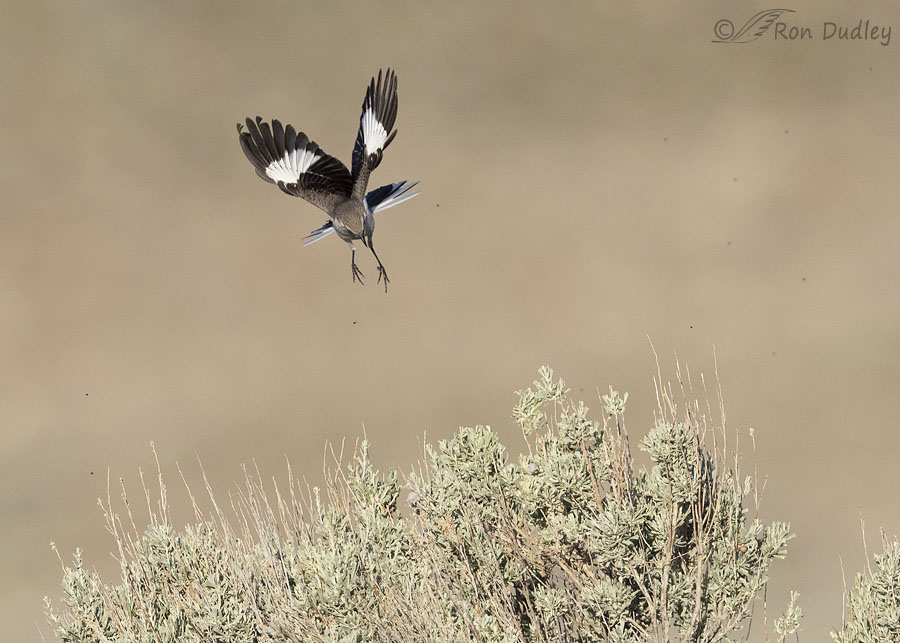
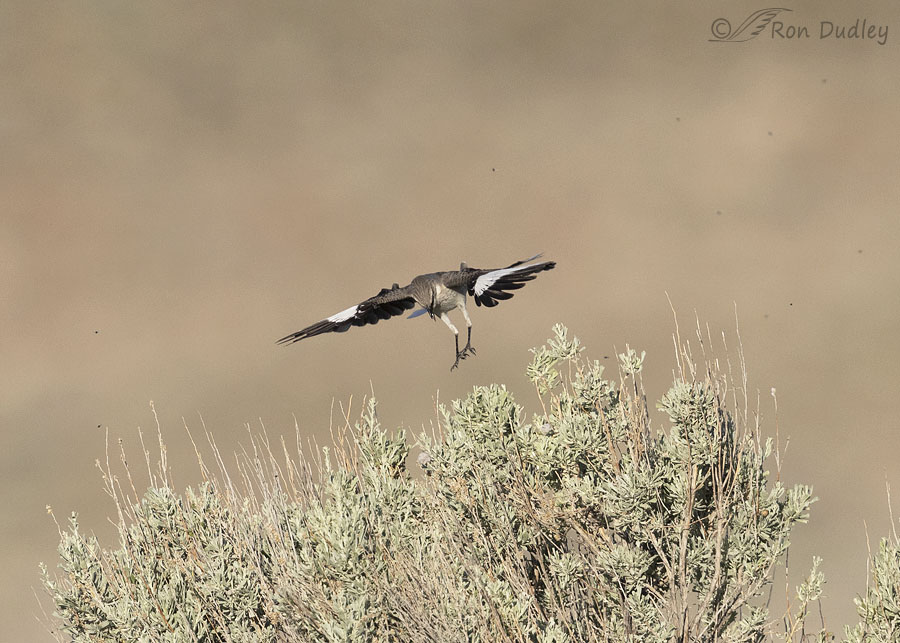
Nearly there.
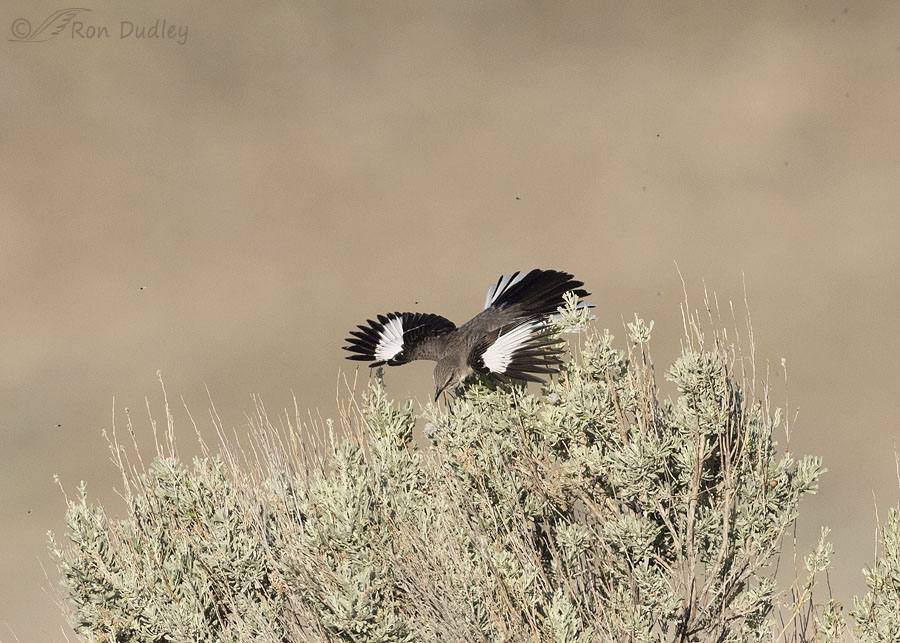
Touchdown. Notice that he landed on the same place on the sagebrush he took off from. His landing wasn’t a good one so he…
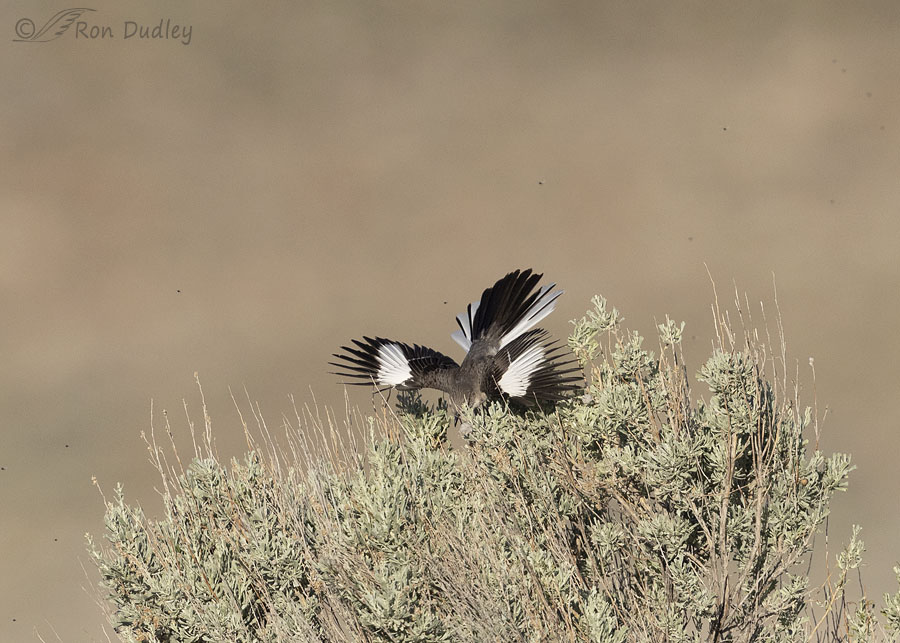
went ass over teakettle in the sagebrush but he soon recovered his balance. After a face plant like this one, recovering his dignity was more problematic.
Yesterday I was lucky enough to get hundreds of sharp shots of this male as he performed 12 different flight displays, often separated from each other by only a few seconds. It really gave my new camera a workout. In this display he wasn’t calling during his performance but in most of them he was.
The series above is complete but it doesn’t include some of my photos that were my favorite flight postures from other displays so…
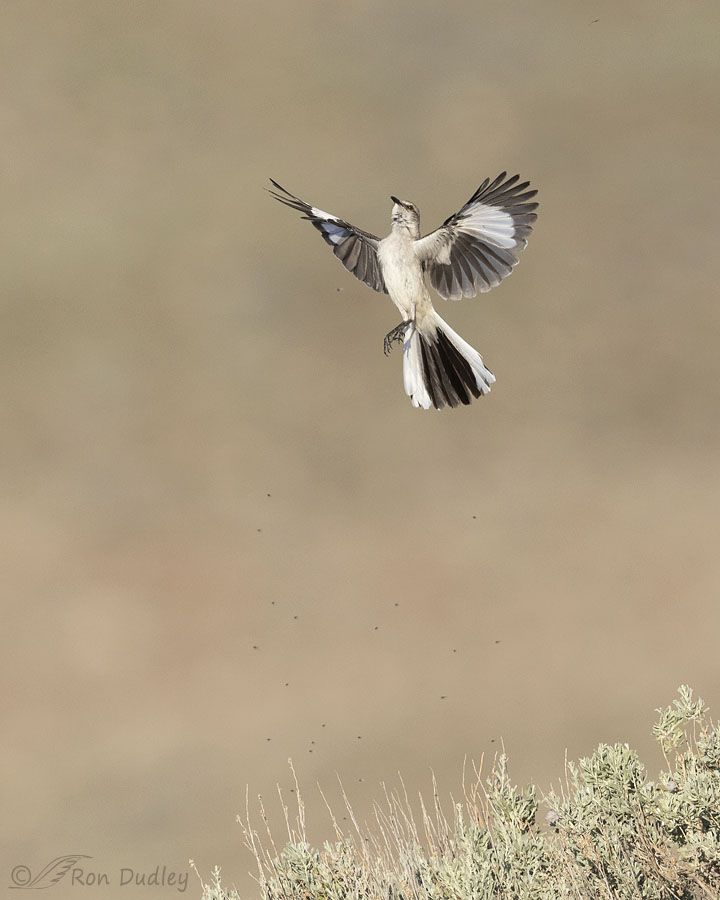
just for the fun of it I’m tacking one of them on at the end of today’s post. This photo was taken while he was flying almost straight up.
Yesterday my timing was good because I believe these flight displays, which are types of courtship displays, are just about over for the year. In fact, soon after these photos were taken, I may have found an active mockingbird nest where the eggs are already being incubated. I didn’t approach the potential nest bush to confirm my suspicions for fear of disturbing the mockingbirds but the activity I saw suggests that there’s a nest in there.
After a mockingbird drought on the island for the last several years, this year has been a good one for them. And for this bird photographer who loves to photograph behaviors.
Ron


Congratulations Ron. Isn’t it wonderful when photos of those nemesis birds or bird behaviors are finally captured? I’m glad the new camera is performing well for you.
You mentioned that Cornell’s Birds of the World says “and the bird sings continuously.” But it looked from your pictures as if the bird’s bill was closed most of the time. Do you remember whether the bird was singing continuously?
Phil, here’s what I said in my post about that:
“In this display he wasn’t calling during his performance but in most of them he was.’
Beautiful Bird Ballet…



Ron, congratulations on finally getting that wonderful series of images! It may have taken ten years, but the results you got are worth the wait and the effort. I’ve been enamored with Northern Mockingbirds since they used to wake me up in the dark early morning hours with their singing…I would hear the bird in our yard sing for a minute or so, only to be answered by another mockingbird down the block. That was about 70 years ago when I was eight or nine and open windows at night was our air conditioning. Other people might have been irritated about being woken up in the early morning hours, but I loved it.
I’ve also been mesmerized by their “flight displays” and have tried and failed, until recently, to capture it with photos. Unfortunately for me, there’s no sagebrush around and the mockingbirds always pick very tall trees to do their singing and flight displays.
I encourage you to do a composite photo with your series. Not only were my photos taken of a mockingbird displaying from the top of a 90’ redwood instead of sagebrush, but my photos are backlight and softer than yours…and yet the composite still reminds me of their wonderful displays.
Ron, I hadn’t thought of the possibility of a composite. It’s something I’ve never done but the concept appeals to me. Thanks for the suggestion.
Thank you Ron. Interesting study. Just love those birds.
Thanks, Michael.
Late to the party this morning (3.30am here).
Wow, wow and wow again.
What an incredible thing to see, to hear, to capture…
I am now wondering what other nemeses (I hope that plural is correct) your new camera and you can partner to blow away…I will assuredly be watching this space.
EC, I have plenty of other nemeses to challenge both me and my camera so time will tell.
And speaking of time, I got up at 3:25 this morning – we’re two of a kind.
Glorious, Ron! Congratulations!
Way more white in the tail/belly than I remembered from our mockers in NJ. I haven’t seen any since we moved to central Washington. The range map shows them all across the country, and maybe they are in the fields around town, but they sure don’t show up anywhere near my yard. I miss them. What a wonderful treat your post is!
Thanks, Carolyn. It’s interesting that their range map includes the entirety of the US, Mexico and Cuba and almost nowhere else, almost like mockingbirds know where the national borders are.
Wow! Great pictures, again! In addition to the artistic and beautiful photos, I so much enjoy the educational aspects of your postings. Thank you!
“I so much enjoy the educational aspects of your postings.”
That’s good to know, Quentin. Much appreciated.
Wonderful series. Do you think you would have captured these with the 7DMII? As I mentioned earlier the mockingbird outside our condo had a nest with hatchlings yet still displayed between foraging and making deliveries of bugs from the ground and berries off a tree. They seemed to like the ripening mulberries.
“Do you think you would have captured these with the 7DMII?”
Highly unlikely, April. I probably would have got a few sharp shots but not the entire performance and definitely not 12 entire performances.
Congrats! While I know it was a lot of excitement for you to wonderfully catch the display, I wasn’t even thinking of that while moving through the photos. Instead, I was just struck by how much fun the mockingbird was having. Thanks!
Kent, it must have been exhausting fun for him. I believe he was doing it for much of the morning.
What a wonderful, detailed series documenting this behavior! The behavior itself reminds me a bit of what lark buntings do for their displays.
I’ve never seen the Lark Bunting display, Nancy. Hopefully some day…
I was trying to wipe those dirt specks off my screen until I started reading.
A worthy goal and well worth the wait. I hope he also achieves his goal in a much shorter time frame.
I think Everett nailed the descriptions for those two photos.
Thanks, Lyle. I hope he does too.
As a teenager, and very fascinated by birds, I watched many times as a Mockingbird displayed, zooming and plunging over his perch on a large rambling rose. It was long ago, so I can’t swear to my memories, but the display went on for years and the bird(s) sang the entire move. One also would dive-bomb my mother’s terrier, and occasionally pluck a hair off it’s little stand-up tail. Their songs were extraordinary and for a science class, I once tried to identify the non-bird sounds in the repertory. I remember two of those sounds, now, a gate hinge in the garden and the special whistle we used to call the horses to come to the barn. Those were the days before small recorders were available, so I had to describe the sounds in words.
You have lots of interesting mockingbird memories, Sallie. Thanks for sharing them.
Delightful. I LOL “ass over tea kettle”…haven’t heard that in a long time LOL
It’s an old favorite of mine, Kellie.
Congratulations, Ron! Beautiful series. I’m lucky enough to have them nesting in the yard, along with Brown Thrashers and Gray Catbirds. Never a peaceful, quiet moment in my yard, and that’s just fine with me! Mine usually do the flight displays from the top of a street light, not nearly as attractive as your sagebrush.
Thank you, Diane. I’ve been waiting for our catbirds to show up but so far I haven’t seen (or heard) a single one.
I want to echo Lori’s comment..WOW..!
These are great photos.
Thank You,
Kaye
Thanks very much, Kaye.
Sensational series Ron. New adventures everyday with the R5. The 2nd shot looks like he is a rocket shot toward the moon, and the 3rd looks like an angel from Heaven. All of the photos whether rising or returning are really good.
The whole thing about the bird and the bush remind me of my grandmother’s saying, “A bird in the hand is worth two in the bush.”
I have only photographed a Northern Mockingbird here once. Sure wish we would see them more often.
Thanks, Everett. I don’t see them very often either. The only place around here where they’ve been reliable, in some years but not others, is Antelope Island.
WOW. Just WoW…fantastic captures. His feather patterns are a testiment to Mother Nature’s artistry.
Your patience and persistence paid off well. Thanks for sharing!
Thanks, Lori. I don’t know how patient I was, given that it took me a decade to succeed. Often times I was highly frustrated so it was sure nice to finally reach my goal.
Absolutely fabulous series – congratulations! And thanks for sharing.
Thanks very much, Burrdoo.
Great display. It must have been fun!
It certainly was, Bruce. And rewarding after so many years of failure.
What one will do for love.
The power of hormones…
WOW! VBG! Need the sagebrush to give perspective to it all. Haven’t heard “ass over teakettle” in some time – VERY appropriate…
Need the sagebrush to give perspective to it all. Haven’t heard “ass over teakettle” in some time – VERY appropriate…  Definitely “buggy” out – glad the no-see-ums were inactive. Good food supply for the birds.
Definitely “buggy” out – glad the no-see-ums were inactive. Good food supply for the birds.
Judy, “ass over teakettle” is one of my favorites from the old days. I’m an “old days” kinda guy.
I use that saying as well. You’re the first person that I have heard use it here in UT.
Lori, given how different I am from the ‘typical’ UT resident it’s probably not my only verbal distinction…
I love the third pose. It looks like he is in pure ecstasy. Great series and well worth the time spent on it.
“I love the third pose. It looks like he is in pure ecstasy”
I see what you mean, Cindy.
I’m certainly impressed! With the bird. The photos are very nice too
Thanks, Porcupine.